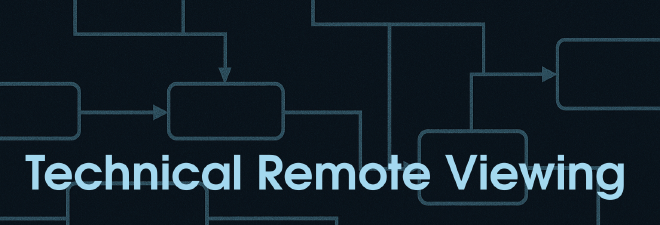What is Technical Remote Viewing?

Technical Remote Viewing (TRV) is a paper based remote viewing methodology developed by Maj. Ed Dames, with the blessing of Ingo Swann1 as a continuation of Swann’s work on Controlled Remote Viewing (CRV). TRV addresses structural shortcomings of CRV and uses a stricter and more detailed structure, however the innards of the method will be familiar to anyone who has studied CRV.
TRV’s main advantage is it’s rigid and well defined structure. The TRV structure’s main innovation is a formalised way to divide a target into logical chunks, examine these in detail and then reassemble them into a coherent summary. While a viewer can certainly do this in other methods, in TRV this is explicit and strictly defined - it’s not optional. This reduces AOL and raises the threshold so that higher level data can flow easily past the analytic mind.
A downside of TRV’s rigid structure is that TRV sessions are long. Training can sometimes feel tedious and like you’re repeating yourself unnecessarily, especially if you’ve got a background in CRV or other less disciplined methods. Sessions take longer than with other methods, and after you’ve completed a full ‘Stage 2’ for the fifth time that day you might find yourself wondering why didn’t I pick a different method to train in?

Here’s why it’s worth pushing through the discomfort:
- You’re getting a lot of practice. Learning ‘by rote’ allows the viewer to get data automatically and effortlessly. In an average TRV session you’re executing more probes for data than in other methods.
- Up until the ‘Site Template’ (ST), which at the absolute earliest is page 8 of the session, the viewer has no freedom to direct the session. You might think this as a bad thing - as inflexible or rigid or likely to make you miss important data - but it’s actually liberating. The intellectual mind can completely switch off without any negative consequences. In remote viewing we’re not trying to train the intellect, and the structural rigidity pre-ST allows that intellect to just get out of the way.
- Compared to CRV where it’s ‘a race to stage 42’, the TRV structure spreads out the collection of S4+ level data across the session, interspersing it with other types of data collection. This allows copious target data to be hidden from the intellectual mind until it’s recombined in the ST. This is A Good Thing.

A common question from beginners to remote viewing is which method should I learn? Which is the best? The truth is that all the different methods do work, all can produce great results and ultimately it’s down to the individual. These different methods are best thought of as training systems. So they’re not “the best way to get data”, they’re “a great way to learn to get data”. When you think about TRV as a training system then all that hard work starts to make sense. After all, if you were learning a martial art you’d spend hours practising the same moves over and over again. If you were learning a musical instrument you’d be doing your scales and arpeggios and theory. Remote Viewing is no different. You can’t learn to swim from reading a book, you have to get in the pool and put in the hours. All that’s left to decide is how you spend those hours - finding a system which works for you and will get you to where you - you personally as a viewer - want to go.
Starting out in Remote Viewing is easy, but mastering it is hard. It takes a long time to master and if your goal is to make money then your time is better spent elsewhere. On the other hand, it’s an incredible journey of self discovery where you’ll have mind-blowing, mind-expanding, ontologically disruptive experiences. It’s a hell of a trip, and if you think you’re one of the rare few who are going to make that journey then you should consider training in TRV.
Major Dames was, as far as I am aware, the only military remote viewer to ever have Ingo Swann’s written permission to teach and develop CRV. ↩︎
‘Stage 4’ in CRV is where analytical, higher level, conceptual, abstract data - i.e. the really useful stuff - is gathered. While it’s great to get lots of this data, digging down in stage 4 for too long can be a minefield where the analytical mind can quietly introduce noise and potentially derail the whole session. ↩︎